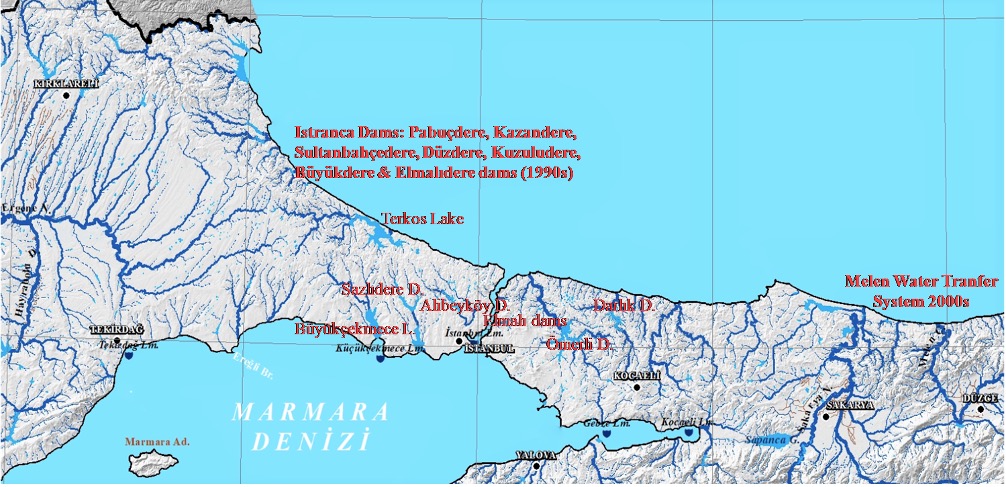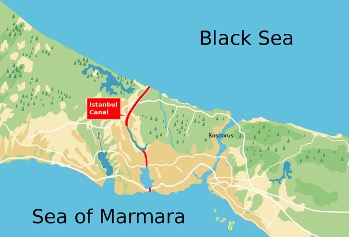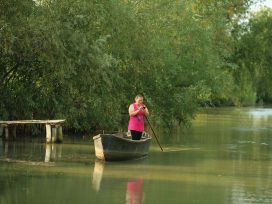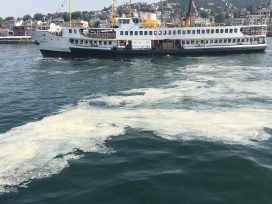Supply, demand or prayer
Istanbul’s water reserves are drying up: increasingly severe droughts, intense urban development and the growing population all have their impact. With no miracle cure in sight, environmental science looks for proven ways to reduce water loss in times of scarcity.
Europe’s most populated city, built between two seas, has a freshwater problem. At the beginning of 2021, Istanbul reservoir levels dropped down to 20%, leaving less than 1.5 months’ supply for around 16 million people. The situation, which was no better elsewhere across Turkey, compelled the government to organize simultaneous pray for rain ceremonies throughout the entire country.1
Both national and international media showed great interest in Istanbul’s water scarcity. Then, when rain started to fall about a week later, the problem was quickly forgotten. However, it would take more than a downpour to resolve a nationwide drought that has been ongoing since 2019. Despite bringing more than half of its water from surrounding cities, Istanbul’s 15 reservoirs, almost half of which are located outside the city, are far from replenished.

Photo by Knieanarchist from Flickr
Water scarcity will soon become an even greater problem in Istanbul and many other Turkish cities. Due to their position in the Mediterranean Basin, they are among the urban areas most affected by climate change worldwide. Floods, droughts, forest fires and heat waves are increasing in frequency and magnitude across Turkey.2 Since the end of the 1980s, the country has gone through drought periods every four to seven years, the most recent event lasting for almost two years. It’s only a matter of time before the next drought will affect an even more densely populated and urbanized Istanbul.3
Will it still be possible for Istanbul to find more water from other cities even though climate change affects them all? Or are Istanbul’s current water supply policies and practices finally coming to an end?
Just how scarce is Istanbul’s water?
Many cities were intentionally built near freshwater sources, but Istanbul is located between the Black Sea and the Sea of Marmara. The Bosporus, meanwhile, divides the city into two peninsulas on the European and the Asian continents. According to historical documents, Istanbul used to have more than 300 large and small streams, half of which have disappeared today, mainly due to heavy urbanization. In addition, the city boasts important lakes, including Terkos, Küçükçekmece and Büyükçekmece.

Istanbul freshwater supplies from Kırklareli to Düzce provinces. Graphic courtesy of author.
During the 1991–2020 climate period, the city’s mean precipitation was 690.5 mm/year, which is above average for Turkey. Its annual water yield is 1.66 billion m3, which includes all reservoirs and water transfer systems built in and outside Istanbul. The average water use per capita is 189 litres. Water use per capita in European countries ranges between a high of 430 litres in Greece and a low of 82 litres in Malta. Istanbul is neither poor nor rich in terms of freshwater supply.
Climate change impacts
A new study indicates that climate change and urbanization jointly exacerbate the water scarcity of world cities, including Istanbul.4 Projections suggest that Istanbul’s climate will become warmer and drier. Average temperatures rises, particularly during the summer, causing not only water loss through evaporation from surface water sources (rivers, lakes and reservoirs) but also heat waves doubling the impact of heat island effects.5
Infrastructure absorbs and re-emits heat from the sun more than natural landscapes. Urban areas, therefore, become heat islands creating higher temperatures relative to outlying areas.6 Although a slight decrease in annual precipitation is expected in Istanbul as a result, its rainfall is heavier in shorter periods, leading to potential floods and reduced water storage capacity.7
Moreover, as in many parts of the world, droughts and heat waves often occur together in Istanbul. During warmer months, when rainfall is at its lowest and water is most needed, the city’s existing water supply-demand imbalance magnifies. For example, when a heat wave hit Istanbul on 2 August 2021, water consumption reached a record high at almost 3.4 million m3, 13% more than the city’s average.
Over the past two decades, many regions of the world have suffered from an increasing number of simultaneous droughts and heat waves, whose combined effects appear to be greater than separate occurrences.8 Research also shows that heat waves affect the quality and quantity of water through the thermal and oxygen dynamics and phytoplankton populations in changing water bodies, causing bursts of cyanobacteria.9
Additionally, excessive rainfall creates adverse effects on the quality of freshwater sources: it mobilizes pathogens in the environment, carrying them into rivers, lakes, reservoirs, coastal waters and wells; it changes the flow and content of rivers; it increases the load on sewerage and wastewater treatment plants, causing waste water to mix with drinking water; and it creates water sanitation problems.10 In short, not only droughts but also other extreme climate-change-induced weather events reduce the availability of clean water in many cities.
Excessive urbanization
Istanbul’s growing urbanization increases both water demand and the residential occupation of land in water basin areas. The city generates 30.7% of Turkey’s economic activity-related GDP and accounts for 18.5% of the country’s population. These figures alone explain a great deal about the household and industrial water demands and overall urbanization pressures on the city’s freshwater sources.
Mega projects such as the Yavuz Sultan Selim Bridge (the third bridge to cross the Bosphorus), the Northern Marmara Highway and a new Istanbul airport add another dimension. All have been constructed in the city’s wetlands and forests over the past decades, contaminating freshwater basins and sealing them with concrete and asphalt. The quantity and quality of freshwater in the Terkos, Küçükçekmece, Elmalı, Ömerli and Büyükçekmece basins are under increasing threat.11
The Canal Istanbul project
Unfortunately, the vicious circle doesn’t end there. The infamous Canal Istanbul project, a shipping route that will join Istanbul’s two seas, is also on its way to creating enormous adverse impacts on already stressed water basins. Despite being presented as a strategic move that will turn Turkey into a logistics base and grant it geopolitical leverage over both regional and international trade and transportation routes, Turkey’s political opposition considers Canal Istanbul to be a rent-seeking project designed to attract international investment in the hope of reviving Turkey’s deteriorating economy.12
The artificial waterway will start at the Black Sea by the Terkos Lake, and swallow the Sazlıdere reservoir and Küçükçekmece Lake once it reaches the Sea of Marmara. The canal will be around 45 km in length and 275 m wide. It will eliminate some of Istanbul’s freshwater resources and put others at risk, pollute groundwater, disable some existing water infrastructure, further increase urbanization’s pressure over freshwater basins and force the construction of additional reservoirs.

The Canal Istanbul project will create a giant island in the middle of two peninsulas. Graphic courtesy of author.
The project will cause the direct loss of a total 73 million m3 of freshwater, equivalent to the monthly water consumption of Istanbul’s entire population. However, an even greater danger lies in the seawater that will be carried through the canal and poses a huge environmental threat: the salinization of the surrounding aquifers, which means that sea salt would even permeate groundwater.
Furthermore, the canal is projected to attract at least an additional 1.2 million people to the residential areas on both sides, and exacerbate the current urbanization pressure on the Sazlıdere, Terkos and Küçükçekmece basins. Local government officials will have to authorize the construction of more reservoirs.
The project will also create a giant island in the middle of Istanbul. How indeed will people on this island be provided with freshwater during climate disasters such as droughts, floods, heat waves or earthquakes?
Can supply-side solutions really fix water scarcity?
By the beginning of the 1990s, Istanbul already faced a growing water shortage problem, mainly due to the severe 1989 drought, an approximately 65% loss of water in its supply network and an increasing demand on water from a rapidly growing population.13 The drought that followed in 1993 justified water storage maximization as an unquestionable drought coping mechanism.
Seven dammed reservoirs were constructed in Kırklareli, Tekirdağ and along Istanbul’s provincial border with Tekirdağ in the 1990s. These reservoirs were supposed to end the water shortage in Istanbul for years to come. However, even in the 2000s, the problem proved to be more complicated.
The 2007 drought spurred the launch of another attempt to solve Istanbul’s water management issues: the Great Melen Project, a 189 km-long water pipeline constructed to carry water directly from the Melenstream, flowing between the Sakarya and Düzce provinces, to Istanbul. When the inter-basin water transfer system opened, local authorities and central government announced that Istanbul would no longer have water shortage issues for the next 60 years. But the 2014 drought proved this wasn’t the case: the Melen River’s water flow had decreased by 50% and the reservoirs built outside of Istanbul in the 1990s had almost no water left in them. The entire water infrastructure built after the 1990s was also almost defunct due to drought and growing urbanization.
In the Kadıköy district of Istanbul, three to four days of water closure brought people out onto the streets: protesters in bath robes held banners that read, ‘my grandchildren don’t kiss me anymore because I stink’.
Today, more than half of Istanbul’s water comes from external freshwater resources scattered in five neighbouring cities: Kırklaeli, Tekirdağ, Kocaeli, Sakarya and Düzce. As climate change and growing urbanization deteriorate Istanbul’s own freshwater basins, a growing population’s demand for water is simultaneously on the rise. Local authorities, obliged to build more reservoirs, speculate in Istanbul’s hinterlands and surrounding cities, carrying water over ever longer distances.
Affected communities who live in the donor basins migrate to cities, the most attractive being Istanbul. This relocation adds fuel to the flame, increasing urban populations and their demand for water in these cities. This downward spiralling situation is fed by the water management practices which focus on the supply side of the equation.
An example to other cities
Istanbul is Turkey’s most populous city, which sets the country’s water management example for other metropolitan areas. Ankara, the capital of Turkey, has built a 100 km long water transmission tunnel to carry water from Bolu. Izmir built the Gördes Dam in Manisa to expand its water supply. Konya meets some of its water demand from the Göksu Basin via the Blue Tunnel, which also provides irrigation water for agricultural production on the Konya Plain.
However, this supply-side water management strategy is becoming increasingly less efficient. Large projects generate high dependencies, risk and vulnerabilities, particularly in the face of climate change. No major city in Turkey can autonomously secure its water anymore.
Decreasing water demand
In an age of environmental precarity, the most effective strategy for increasing water supply has proven to be decreasing demand. Cities like Istanbul could avoid or at least postpone buliding new dams, should they focus on water saving and efficiency measures instead: minimizing losses in water distribution systems, maximizing greywater reuse, rain harvesting, installing water-saving devices and raising public awareness.
Istanbul could also reduce its 20% physical water loss by improving its water distribution system.14 While the city already meets the legally binding target of reducing water loss to 25% in all Turkish metropolitan and provincial municipalities by 2023,15 there is a lot of room for improvement when compared with efforts seen in Denmark, Germany and the Netherlands, where the average water losses are below 10%.16 Meanwhile, the national water loss average, which comes in at 39.2%, needs significant work.17
Thanks to central and local government efforts, all new buildings taking up more than 2,000m2 will legally have to integrate a rainwater collection system from this year onwards. Shortly after this decision was made, many local governments, including Istanbul Metropolitan Municipality (IBB), adopted the improvement into their own legislation. IBB and İSKİ are also working on making the greywater reuse in new buildings a legal obligation. In addition, the İSKİ has begun installing special water-saving devices for high water consuming households in three districts. Local authorities have meanwhile started to raise public awareness of water saving via social media and TV.
Persistent policies
Despite these efforts, however, the supply-side approach to water management is extremely persistent. They dominated the national water strategies of many countries. More than 57,000 large dams are being built around the world cities transfer 504 billion litres of water per day over a cumulative distance of some 27,000 km through inter-basin water transfer systems at high economic, social and ecological costs.18
Millions of people worldwide have had to migrate to cities due to the construction of dams impacting their access to water and land. These infrastructures interrupt, modify and often irreversibly damage river water cycles and flow regimes. Ironically, dams and reservoirs, which are built for climate change mitigation and adaptation, are responsible for 4% of anthropogenic carbon emissions all over the world – almost as much as global aviation emissions.19
Demand-side potential
Such maladapted projects and strategies are increasingly questioned and problematized by academics, politicians, affected communities and activists all around the world. ‘Demand-side’ water policies are not a fantasy. Although no single country or city fully meets the requirements of demand-side policies, at least partially successful practices do exist.
One system is Berlin’s closed-water-cycle approach, which ensures that all water consumed within the city comes from internal sources: more than 90% of Berlin’s water is provided from local sources.20 The city’s groundwater supply is enriched by bank filtration and rainwater infiltration techniques, combined with leakage reduction in water distribution systems and curbing domestic water use.21 Another example is Amsterdam, which has reduced its water loss down to 4%. The city has a holistic water management system that considers reservoirs, storm water, groundwater and recycled water as integral parts of a single water management approach.
China’s ‘sponge cities’, where precipitation is stored through nature-based solutions for improving drainage, filtering out pollutants and storing excessive storm water to use during droughts, provide other positive examples. In all of these cases, water is managed in a circular fashion with no need to collect water in invasive, inefficient ways. In a finite world with finite resources, water management can no longer afford to be driven by supply.
A demand-side water policy for Istanbul
Unless Turkey adapts its freshwater strategies to climate change, its water shortage issues will accelerate, even earlier than anticipated.22 As the driving force behind Turkey’s economy and role model to other Turkish cities, Istanbul should rapidly adopt demand-orientated water policies that are compatible with climate change. The political will of local authorities is vital in standing against the dominant supply-side water management paradigm. Civil society organizations and the general public also need embrace the steps that the IBB and İSKİ have already taken towards demand-side water management.
Building more dams in other cities and carrying water from other basins won’t eradicate growing water scarcity. Climate change recognizes no borders. No water resource is immune to it, nor should be seen as a consistent and secure supply under existing climatic circumstances. Supply-side approaches to water management will only further postpone a belated adaptation to climate change, push Istanbul further into a vicious cycle and make the city more vulnerable in years to come. The future of Istanbul might depend primarily on how fast it can adopt demand-side water policies. Istanbul’s overall sustainability is at stake.
Administered by the Turkish Directorate of Religious Affairs.
UN-Water (2020): United Nations World Water Development Report 2020. Water and Climate Change. Paris: UNESCO. https://digitallibrary.un.org/record/3892703?ln=en
The population density of Istanbul is 2976 people per km2.
Chunyang et al. (2021): “Future global urban water scarcity and potential solutions”, Nature Communications, 12, 4667. DOI: 10.1038/s41467-021-25026-3
Istanbul Climate Change Action Plan, Summary Report 2018. https://www.iklim.istanbul/wp-content/uploads/%C3%96zet_Rapor_%C4%B0ngilizce.pdf
United States Environmental Protection Agency (EPA). https://www.epa.gov/heatislands/learn-about-heat-islands
Istanbul Climate Change Action Plan, Summary Report 2018. https://www.iklim.istanbul/wp-content/uploads/%C3%96zet_Rapor_%C4%B0ngilizce.pdf
S. Mukherjee & A. K. Mishra (2021): “Increase in compound drought and heatwaves in a warming world”, Geophysical Research Letters, 48, e2020GL090617. DOI: 10.1029/2020GL090617
Woolway, R.I. Jennings & L. veCarrea (2020): “Impact of the 2018 European Heatwave on Lake Surface Water Temperature”, Inland Waters, 10:3, 322-332, DOI: 10.1080/20442041.2020.1712180
K. F. Cann et al. (2013): “SystemicReview: Extreme water-related weather events and waterborne disease”, Epidemiol. Infect., 141, pp.671-686.
D. E. Okumuş, H. Türkoğlu & A. Tanık (2018): İçme Suyu Havzaları ve Kentsel Yerleşmeler https://www.skb.gov.tr/icme-suyu-havzalari-kentsel-yerlesmeler-s28361k/
T. Eldem (2021): Canal Istanbul. Turkey’s Controversial Megaproject. Its likely impacts on the Montreux Convention and regional stability, SWP Comment 2021/C 43, 20.07.2021. DOI:10.18449/2021C43
Istanbul’s population almost doubled between 1980 and 1990, reaching 7.3 million.
Istanbul Water and Sewerage Administration, Water Loss in 2019 (in Turkish). https://www.iski.gov.tr/web/assets/SayfalarDocs/sukayiplari/Su_Kay%C4%B1plar%C4%B1_2019.pdf
Turkish Ministry of Forestry and Water Affairs (2014) İçme Suyu Temin ve Dağıtım Sistemlerinde Su Kayıplarının Kontrolü Yönetmeliği, 8 May 2014, OfficialGazette No: 28994.
EurEau (2017): Europe’s Water in Figures. An overview of the European drinking water and waste water sectors. https://www.eureau.org/resources/publications/1460-eureau-data-report-2017-1/file
I.E. Karadirek (2016): "Urban Water Losses Management in Turkey: The Legislation and Challenges", Anadolu University Journal of Science and Technology, Applied Sciences and Engineering, 17 (3), pp.572-584. https://dergipark.org.tr/en/download/article-file/229193
R. I. McDonald et al. (2014): "Water on an Urban Planet. Urbanization and the reach of urban water infrastructure", Global Environmental Change, 27, pp.96-105.
I. B. T. Lima, F. M. Ramos, L. A. W. Bambace & R. R. ve Reinaldo (2007): Methane Emissions from Large Dams as Renewable Energy Resources. A developing nation perspective. MitigAdaptStrategGlobChange, 13, pp.193–206. https://doi.org/10.1007/s11027-007-9086-5
T. Moss (2016): “Conserving Water and Preserving Infrastructures between Dictatorship and Democracy in Berlin”, Water Alternatives, 9 (2), pp.250-271.
P. Salian & B. Anton (2010): Making Urban Water Management more Sustainable: Achievements in Berlin, SWITCH, Freiburg: ICLEI EuropeanSecretariat.
Ü Şahin & L. Kurnaz (2014): İklim Değişikliği ve Kuraklık. http://ipc.sabanciuniv.edu/publication/iklim-degisikligi-ve-kuraklik/?lang=en
Published 15 September 2021
Original in English
First published by Eurozine
© Akgün İlhan / Eurozine
PDF/PRINTIn collaboration with
In focal points
Newsletter
Subscribe to know what’s worth thinking about.
Related Articles

Assaults on academic freedoms in the US mirror those happening in Turkey for the past decade. Erdoğan’s silence about clampdowns on pro-Palestinian speech at US universities, even when Turkish scholars are directly affected, is particularly telling.

Popular culture in flux
Varlık 5/2025
In Varlık: how northern cultural hegemony is being challenged by Bollywood, Korean television dramas, K-pop and Nollywood; also, post-emotional human relationships and the aesthetics of uncertainty.








